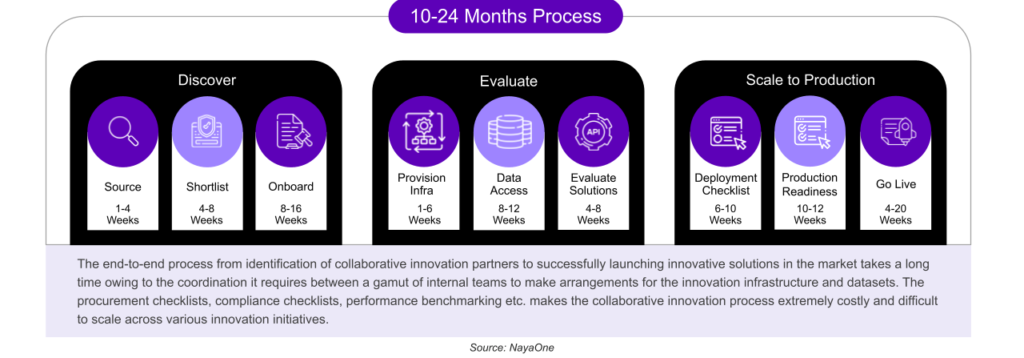Author: NayaOne – nayaone.com
What is a Sandbox?
Within Financial Services, a sandbox is a testing environment that allows firms to experiment with new technologies, ideas, and products without risking their reputation, touching their technology stack, or exposing customers’ data.
How can a Sandbox help us?
- Deliver Transformation: A sandbox allows firms to innovate faster and at a lower cost because they can test new ideas and technologies in a controlled environment before deploying them in production.
- Reduce Risk: By using a sandbox, firms can identify and mitigate potential risks before they become real problems. This reduces the likelihood of security breaches, data leaks, or integration challenges that could harm customers or their businesses.
- Compliance: Many regulatory frameworks require financial institutions to test new products and services in a sandbox before deploying them in production. By using a sandbox, firms can ensure they are complying with the regulations and avoiding costly fines.
- Enable Collaboration: A sandbox facilitates collaboration among different teams and departments both within the firm and with external partners. This allows firms to share knowledge, expertise, and best practices but also to co-create solutions, and deliver proof-of concepts, with vendors, partners, and customers.
- Competitive Advantage: By leveraging a sandbox, firms can accelerate their time to market for new products and services, gaining a competitive edge over peers who are slower to adopt new technologies.
This all sounds great… but what risks should we be aware of and can they be mitigated?
- Data Security: While sandboxes are designed to be secure, there is always a risk that sensitive data could be exposed or compromised during testing. There are two main ways to mitigate this risk: Firstly, never use real data and secondly, work only in a sandbox that sits outside your technology estate. The alternative to real data is using either anonymised or synthetic data.
- Integration Challenges: Moving from a sandbox environment to production can be challenging, as integrating the new technology or product with existing systems and processes may require significant effort. To mitigate this issue technologists can use a sandbox to explore the integration challenge of delivering the new technology to create a clear cost and time estimate of the effort required.
- Cost: There are costs associated with setting up and maintaining a sandbox environment, including hardware, software, and personnel. Financial technology solution provider like NayaOne provide a pay-as-you-go model so firms can access these environments only when they need them, avoiding the in-house setup and maintenance expense.
How does this change my existing process?
The adoption of new technology in most Financial Institutions can feel like a marathon. Go-live often occurs 2-3 years after the problem or use case has been identified. The graphic below illustrates the often-sequential steps many firms go through in their Discovery, Evaluation, and Scaling to production.
This process is slow and inefficient and can lead to a host of challenges; business units lose interest, vendor’s businesses change, buyer’s remorse creeps in and frustration with the method kills any culture of innovation. To circumvent this, many decide to short-circuit the evaluation stage and run selection by PowerPoint and demo. While this can add pace it adds material integration risk should the solution not quite have the functionality expected or is harder to establish than expected.
Sandboxes improve the process in a myriad of ways.
- Discovery: using sandboxes that sit outside a firm’s technology estate allows them to test the vendor technology before burning legal and procurement resources on onboarding. This adds pace.
- Evaluation: Using sandboxes, and with a clear understanding of what you’re testing for, enables tech teams to evaluate multiple vendors against a common use case, a common data set and clear KPI’s. These might include response times, scalability, CX and UI feedback, and feature assessments. Genuine like-for-like comparisons of the solutions, with auditable outputs, provide rich data to support the business case for the preferred supplier. Robust choices, made with data, lowers the risk of buyer’s remorse.
- Once a preferred supplier has been identified the firm can begin the onboarding process. Concurrently, they can use the sandbox to assess the integration challenge of bringing the technology inside the tech stack. This can provide a much clearer view of the likely cost and timeline of the integration, mitigating risk of over-running delivery.
Our experience working this way suggests financial services firms can halve their time to market with new technology. Using NayaOne’s Digital Transformation Platform, synthetic data, tech marketplace and a Digital Sandbox, discovery and evaluation can be delivered in 6 weeks.
NayaOne provides Digital Sandboxes that support any type of technology in an off-estate environment. Public cloud hosted, with strong Governance and controls, we also provide synthetic data and a marketplace of Fintech vendors to enable our end-to-end platform that transforms go-to-market times.
To learn more about how our clients use sandboxes for different use cases and how you could benefit from Sandbox services, Request a Demo!


